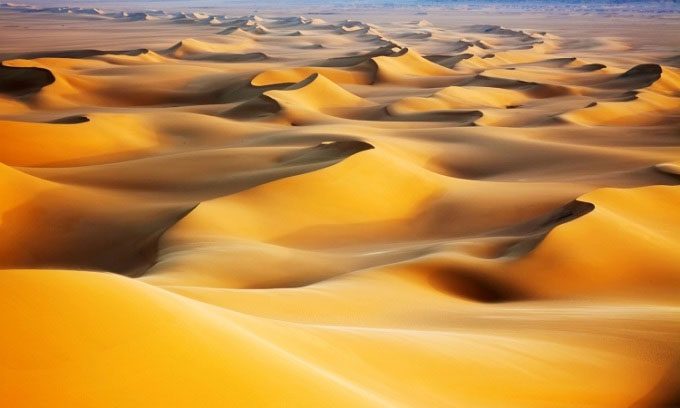The loss of the massive moisture source from the sea and the reduction of vegetation cover have transformed the Sahara from a lush green oasis into the largest hot desert in the world.
Millions of years ago, the Sahara was an oasis filled with trees and grasslands. Today, it is the largest hot desert on Earth, covering an area equivalent to that of the United States. During much of the Late Cretaceous and the Paleogene periods, between 34 and 66 million years ago, the southern and central regions of the Sahara experienced a hot and humid climate due to equatorial rains. Chemical weathering took place beneath a thick layer of lush vegetation rich in organic matter, with rocks exposed near the surface weathered to depths of up to 50 meters.

The Sahara Desert covers an area of 5.6 million km². (Photo: LucynaKoch).
Throughout the subsequent Miocene epoch (5.3 – 23 million years ago), the region underwent uplift and aridification due to climate change. This drying trend was exacerbated by two distinct factors.
- The first was the shrinkage of the Tethys Sea at the end of the Miocene as Africa moved northward towards the Eurasian continent. The Mediterranean Sea is a remnant of this once vast body of water. As a result, northern Africa lost a bountiful source of moisture that had been blown in from the Tethys Sea.
- The second crucial factor was the global cooling phenomenon that occurred 6 to 8 million years ago, leading to the spread of modern ecosystems of flora and fauna that we are familiar with today.
Uneven uplift across the Sahara during the Miocene, combined with drought and reduced vegetation cover, led to a period of intense erosion of the Earth’s surface. In many areas of the Sahara today, large boulders precariously rest atop smaller stones as evidence of this process. The uplift of the Sahara caused a series of erosional flows, with rivers draining from the highlands depositing gravel, sand, and clay throughout the Sahara.
The origins of the desertification of the Sahara may date back to this time. However, the Sahara was not entirely arid during the Miocene as it is today. There were prolonged periods of a more humid climate, allowing Mediterranean vegetation to gradually migrate southward into the southern and central Sahara, while flora from the humid tropical region slowly moved northward.
A series of significant events occurred at the end of the Miocene, around 5.33 – 5.96 million years ago. During this time, the Mediterranean Sea was repeatedly isolated from the Atlantic Ocean, drying up for centuries at a time and becoming a salt desert. Some geologists believe that the recurring desiccation of the Mediterranean Sea was caused by tectonic movements, while others suspect it was due to fluctuations in sea level. Regardless of the cause, the desiccation of the Mediterranean Sea further deprived northern Africa of its substantial moisture source. As a result, the gradual emergence of vast, arid lands gave rise to what we now know as the Sahara Desert.


















































